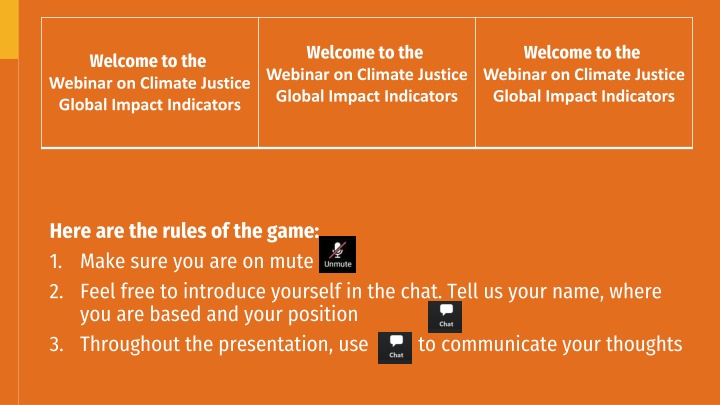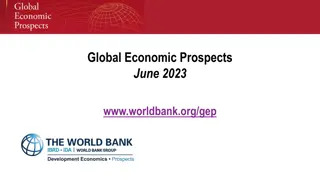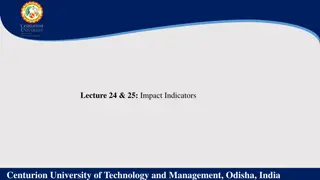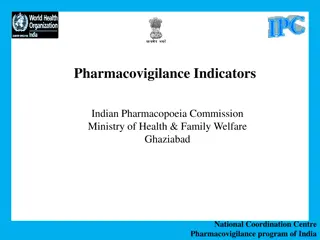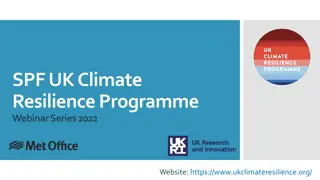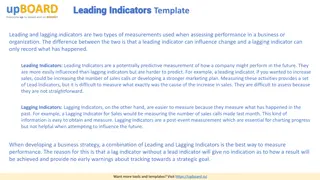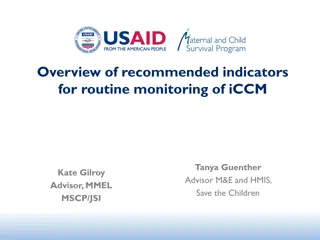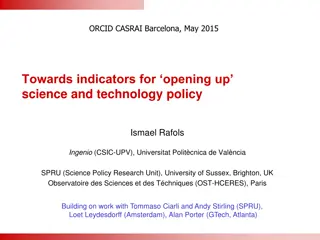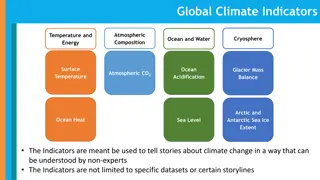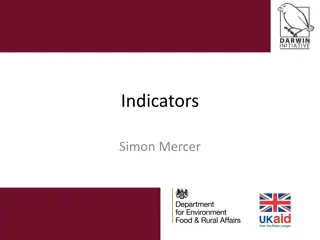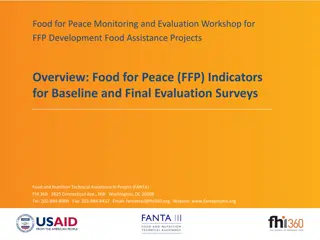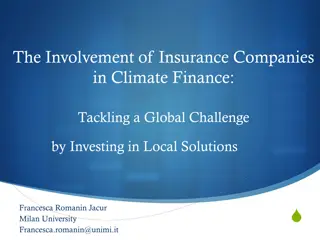Climate Justice Global Impact Indicators Webinar - June 2023
Explore the Climate Justice Theory of Change, key definitions, impact indicators, and the importance of climate-relevant decision-making in this informative webinar. Gain insights on climate adaptation, resilience, and the effects of climate change, all aimed at empowering marginalized communities to combat climate challenges effectively.
Download Presentation

Please find below an Image/Link to download the presentation.
The content on the website is provided AS IS for your information and personal use only. It may not be sold, licensed, or shared on other websites without obtaining consent from the author.If you encounter any issues during the download, it is possible that the publisher has removed the file from their server.
You are allowed to download the files provided on this website for personal or commercial use, subject to the condition that they are used lawfully. All files are the property of their respective owners.
The content on the website is provided AS IS for your information and personal use only. It may not be sold, licensed, or shared on other websites without obtaining consent from the author.
E N D
Presentation Transcript
Welcome to the Webinar on Climate Justice Global Impact Indicators Welcome to the Webinar on Climate Justice Global Impact Indicators Welcome to the Webinar on Climate Justice Global Impact Indicators Here are the rules of the game: 1. Make sure you are on mute 2. Feel free to introduce yourself in the chat. Tell us your name, where you are based and your position 3. Throughout the presentation, use to communicate your thoughts
Webinar on Climate Justice Global Impact Indicators June 2023
Climate Justice Theory of Change (ToC) Key Definitions Impact Indicators (and The Why) and Ex. of What To Report Agenda Agenda What you should know or do! Key Resources Q&A sessions 3
CJ Theory of Change (ToC) Ind 29: # of formal and informal groups, organizations and/or movements that have influenced formal and informal climate- relevant decision-making by channeling or amplifying the priorities of the poorest and most marginalized people vulnerable to climate change. Ind 17 CJ: # of new/amended or better implemented ambitious climate-relevant policies, legislation, multilateral agreements, programs, and/or budgets which increase people of all genders ability to adapt to the effects of climate change, foster climate resilience and/or low greenhouse gas emissions development Ind 28: # and % of people of all genders that have used their increased capacities for resilience and adaptation to the effects of climate change. Impact goal : 25 million poor and marginalized people, particularly women and girls, have strengthened their resilience and adaptive capacities to the effects of climate change.
Key Definitions Climate adaptation is aprocess of adjusting to actual/expected climate change and its effects to moderate/avoid harm or exploit beneficial opportunities. Climate is how the atmosphere behaves over relatively long period of time. Climate resilience is managing risk and dealing with climate related shocks and stresses Climate Change is changes in the state of the climate that persist for an extended period, typically decades or longer. Current changes in climate are (largely) caused by human activity. Due to climate change, slow onset events keep increasing and extreme weather evens are becoming more intense: Ex. Slow onset events Ex. Extreme weather events Effects of climate change: Rising temperatures & sea levels Changing rainfall patterns, heatwaves, drought, glacier melting Hunger, poverty, degradation Droughts Rising sea levels and associated saltwater intrusion Increasing temperatures Erratic weather patterns including changing monsoons dynamics Land & forest degradation/natural resource degradation Loss of biodiversity Increasing desertification Ocean acidification Floods Outbursts and landslides Storm surges Heatwaves and wildfires Typhoons, cyclones, hurricanes environmental Climate-relevant decision-making is a decision making which has an impact on climate change or people s resilience to climate change 5
Climate Justice Impact Indicators (and The Why) and Ex. of What To Report
Core Indicator 28. Climate Resilience and Adaptive Capacity: # and % of people of all genders that have used their increased capacities for resilience and adaptation to the effects of climate change. Measure and report against one or more of the sub-indicators but also generate a unique total impacted (without double counting)under this core ind. 28. Ind. 28 is a composite indicator broken down into 7 sub-indicators that measure different capacities in relation to climate resilience, due to complexity of the concept of Climate Resilience (CR) and the wide range of possible ways in which we can measure impact around Climate Resilience Why do we measure climate resilience and adaptive capacities? To achieve climate resilience, people of all genders need to increase their capacities to: 1) anticipate risks (or foresee and reduce impacts of hazards), 2) absorb shocks and stresses (or accommodate immediate impacts of shocks/stresses by changing usual behavior), 3) adapt to evolving conditions (or adjust behavior to changed circumstances) and 4) transform systems and structures (or influence enabling environment for individual and systematic change) Consider all the seven sub-indicators and make informed judgement on which is suitable to report under core ind. 28
Sub-indicators for Pathway 1: Increased capacities and assets for people of all genders. a. Sub-indicators for measuring the impact from capacities to absorb, anticipate and adapt to climate-related shocks and stresses: 28.1 Climate-resilient livelihoods: # and % of people of all genders that have applied at least 3 practices to protect their livelihoods from negative impacts of climate related shocks and stresses. 28.2 Climate information: # and % of people of all genders that have applied climate knowledge and information services to inform their adaptation strategies. b. Sub-indicators for measuring the impact from strengthening peoples capacities to transform systems and structures relevant to climate resilience: 28.6. Formal/informal decision-making: # and % of people of all genders who have actively participated in formal and informal climate-relevant decision-making spaces. 28.3 Financial services: # and % of people of all genders that have used formal and informal financial services in ways that actively support climate resilience. 28.4 Climate resilient housing: # and % of people of all genders that took at least 3 steps to protect their housings and direct surroundings from the negative impacts of climate related shocks and stresses. 28.7. Household decision-making: # and % of people of all genders who have actively participated in climate-relevant decision- making at household level. 28.5 Sustainable energy: # and % of people of all genders that have used affordable, reliable, and sustainable energy services. 8
Sub Ind. 28.1, # and % of people of all genders that have applied at least 3 practices to protect their livelihoods from negative impacts of climate related shocks and stresses. Only report people that have applied at least 3 practices. Examples of practices that you can report are: Livelihood diversification. Compensation of production as a result of climate change Planting fast maturing/drought resistant crops Changing livestock to withstand recurring droughts (cattle to camel) Commercial destocking before drought Application of Agroecology/SuPER approaches Nature based solutions, such as Mangrove planting to protect fish nurseries. Why do we measure climate resilience livelihoods? Livelihoods are at the heart of CARE s work and are impacted by climate change failing agricultural How do we define it? Livelihoods are activities required for a means of living. Ex. agriculture, livestock, livelihood, and employment Livelihood is climate-resilient when it can cope with and recover from climate related shocks and stresses and maintains its capabilities and assets now and in the future, without undermining natural resource base. capacities, assets and fishing, informal Disaggregate by: Sex, age and type of livelihood (ex. agriculture, livestock, livelihood, employment, other) If a project is about nutrition, it could be measuring food security (FWN indicator) but it could also be tracking a CLJ indicator like 28.1 (livelihood strategies to protect from with shocks that affect nutrition) fishing, informal 9
Sub Ind. 28.2, # and % of people of all genders that have applied climate knowledge and information services to inform their adaptation strategies. Why do we measure application of climate knowledge and information services? Ex: Planting earlier following advice provided after the participatory scenario planning workshop Evacuation after early warning alert of upcoming storm surge Commercial destocking department of livestock declared drought. Combined knowledge on climate change and access to regular updated climate info (short term weather forecasts and long-term climate trends) is key to inform adaptation strategies, leading to increased climate resilience. How do we define it? Climate Knowledge ishaving a good understanding of processes that lead to climate change and how its impacts are affecting the lives and livelihoods of people Climate info services is provision of climate info in a way that assists decision-making by individuals and organizations. They are tools and processes that enable decision makers and users to assess and prevent and prepare for potential impactful weather and climate events. Adaptation strategy identifies and assesses how impacts of climate change will likely affect all aspects of live and what actions need to be taken to achieve climate resilience in the short and long term (including livelihoods, shelter and its surrounding, education, health and wider context) after After a communal process of conducting a CVCA, a community decided on tree planting on steep hills, to reduce the risks of landslides related extreme weather events to more 10
Sub Ind. 28.3, # and % of people of all genders that have used formal and informal financial services in ways that actively support climate resilience. Why do we measure access to financial services (FS)? Improved access to FS enables the poorest and most marginalized to access savings, allow for money lending and take insurances for crop failure or restoring damaged housing. The relevant financial services will be context specific How do we define it? FS are any economic activities and services provided by the finance industry including mobile money services. The services include savings or deposit services, payment and transfer services, credit and insurance. Recommendations: WEJ IA is encouraged to adopt, measure and report Report if people have used formal or informal FS in a deliberately to support their climate resilience Exclude FS that are supporting negative coping strategies (e.g. loan to invest in charcoal business) or that are exploitative (e.g. loan with high interest rates that one cannot afford), reducing the (long term) resilience to climate change. Ex: Loans from individuals, VSLAs or banks to invest in new climate resilient practices (e.g. purchase of pump for irrigation, planting fruit trees, to dig a well to get through prolonged drought season, diversify livelihoods). Informal emergency cash loan from family to respond to climate shock. Savings, to ensure a financial buffer to recover after a climate shock or stress. Users/farmers turn in part of their harvest and are given a loan by a local microfinance institution working with the project/community Crop insurance that offers farmers post disaster liquidity offering protection to their livelihood. Health insurance that can help face health consequences from heat waves for example. 11
Sub Ind. 28.4, # and % of people of all genders that took at least 3 steps to protect their housings and direct surroundings from the negative impacts of climate related shocks and stresses. Report if three or more measures have been applied to protect housings and/or surrounding from the negative impacts of climate change. Why do we measure climate resilient housing protective measure? Ex. With climate change, houses housing and direct surroundings become increasingly vulnerable. Ex. floods can wash away houses; storm can destroy roofs/houses; and heatwaves can make living in a house or shelter unbearable. Deliberate site selection of housing, taking in consideration climate related shocks and stresses such as landslides and storms. Selection of construction materials taken into consideration effects of climate change. Adaptations in construction techniques. Ex. typhoon proof joints for roof, building on stilts, ventilation, insulation). Protection of water well from flooding. Taking out a home insurance to cover costs for repair or rebuilding in case of damages. Activities in the surrounding to protect housing. Ex. trim trees around house, grow shade trees for heat reduction, drainage to avoid flooding, tree planting to limit landslide risks in mountainous area, waste collection to facilitate water evacuation and avoid flooding. How do we define it? Housing and direct surroundings are homestead, consisting of housing and surrounding (land and vegetation) that might affect housing. Recommendations: Humanitarian IA is encouraged to adopt 12
Sub Ind. 28.5, # and % of people of all genders that have used affordable, reliable, and sustainable energy services. For cooking, these are the actual users of improved cookstove and/or users of clean fuels. Why do we measure utilization of energy services? For CARE, the main aim for working on sustainable energy is to halt the usage of polluting energy sources such as charcoal (for cookstoves) and kerosine (for lamps) to reduce health impacts, reduce the labor burden for women, reduce the pressure on natural resources and provide opportunities for women economic empowerment. Added benefit is a reduction in CO2 emissions from this work. How do we define it? Affordable energy is considered affordable if a HH doesn t have to spend more than 5% of HH income on it Reliable access means minimum of 4 hours available per day, minimum 3 watts (12 watts per day-minimum household needs) Energy service is considered sustainable if it meets the needs of the present without compromising the generations (renewable energy sources, clean/improved cooking solutions) 13 For electricity, this is the total of HH members that benefit from renewable energy sources such as wind, solar, hydropower, geothermal and biomass. Ex: People using solar home systems to charge phone, lighting at night and possibly a radio, reducing need for batteries and kerosine. People using improved cookstoves (Tier 2 or above), reducing their usage of charcoal and firewood. People using clean fuels such as LPG, Ethanol or electricity, reducing their usage of charcoal and firewood. People using clean burning stoves such as solar cookers, reducing their usage of charcoal and firewood. People use biogas installation for cooking and/or electricity in house, reducing their usage of charcoal and firewood for cooking and kerosine for lighting. People connected to solar mini-grid and use electricity to replace kerosine lamps for light bulbs In refugee camp people use LPG stoves, to reduce pressure on nearby forest for firewood collection. Women using solar lighting to start a shop Women get connected to solar mini grid to start tailor business needs of future
Sub Ind. 28.6, # and % of people of all genders who have actively participated in formal and informal climate-relevant decision-making spaces. Why do we measure active participation in formal/informal decision- making? pushing for inclusion of activities to prepare for disaster and enhance land-use planning (formal). Ex. Women are participating in Community 5-year planning and budgeting meetings and Transformative capacities like people s capacity to influence formal/informal rules, plans, policies and legislations is crucial to climate resilience. Youth being part of a CBA process, participating in decision-making about adaptation options that will affect their future livelihoods (informal). Pastoralists are part of the clan meeting that decides on usage of scarce water resources between clans during dry season and they are able to voice their water needs to the group (informal). How do we define it ? A marginalized groups are partaking in a consultation meeting for NAP (National Adaptation Plan) and have an official time slot for presenting their messages on the agenda (formal). Active participation means project participants not only attend meetings but are able to contribute to decisions: voice their demands; show leadership; and vote. Women are part of NRC, that discusses how to prevent erosion and restore rangelands and each participant has time to express their opinion during meeting (formal). interests or Women being part of a VSLA group, making decision on investments that are increasing resilience to climate change (informal). Community representatives participate in advocacy workshop at different levels to raise their concerns on climate change related issues that impacted their community (informal). 14
Sub Ind. 28.7, # and % of people of all genders who have actively participated in climate-relevant decision- making at household level. Why do we measure active participation in household decision-making? Active engagement and participation in HH decision- making is crucial. Women and youth are agents of change who must equally be part of the solution for a sustainable future. Equal voice and active participation is key to adapt and transform in the new climate reality. mitigating the unequal impact on health, and thus the unequal risks from climate shocks and stresses. EX: Women are able to make decision(s) in relation to savings for a water pump to harness yields from drought. Women and men make joined decisions on evacuation in advance of cyclone warning. Youth that discuss in the household alternative income generating activities away from traditional charcoal making to reduce pressure on the ecosystem. Young girls that discuss in the household the possibility to continue education and pursuit a career in the city, to generate alternative income sources to cope with declining harvests from failing rains. Women have equal say in decisions related to selection of cash crops that can withstand extreme weather. Women and men make decisions together for diversifying livelihood source, to counter declining income from fishery as a result from coral bleaching. Paid and unpaid household and productive work is equitably shared between adults, Women and men have equal access to and control over productive resources, services and markets, and both participate across the whole value chain, strengthening their coping mechanisms to deal with climate shocks and stresses. 15
Core Ind. 17CJ, # of new/amended or better implemented ambitious climate-relevant policies, legislation, multilateral agreements, programs, and/or budgets which increase people of all genders ability to adapt to the effects of climate change, foster climate resilience and/or low greenhouse gas emissions development Generally, a policy must be formally adopted to count as a win; the introduction of a bill in parliament or proposal of a new gender policy, for instance, would not yet qualify. When measuring it, we start focusing on the outcome level, tracking the changes in policy and/or practice that result from CARE and partners advocacy or other efforts. And only when possible and relevant, we measure the number of people who potentially or actually benefit from those policy changes. Use the Advocacy and Influencing Impact Reporting (AIIR) data/evidence can be reported in the PIIRS IMPACT form. Why do we track new/amended or better implemented ambitious climate-relevant multilateral agreements, programs, and/or budgets? People can only strengthen their resilience to climate change, if formal policies, legislation, multilateral agreements, programs and budgets allow and support them to build and act upon their capacities. How do we define it? Ambitious is context specific Low greenhouse gas emissions refers to the targets used during Paris Accord 2015 of limiting global warming well below 2.0 degrees with ambitious to stay within 1.5 degrees. Disaggregate by adaptation, disaster risk mgmt. and response; mitigation; sustainable natural resources and ecosystem management/protection; climate finance; emission reduction targets policies, legislation, tool and the 16
Core Ind. 29, # of formal and informal groups, organizations and/or movements that have influenced formal and informal climate-relevant decision-making by channeling or amplifying the priorities of the poorest and most marginalized people vulnerable to climate change. Examples: How do we define it? A CSO that represents disabled people, manages to put disability on the agenda of the new policy guidelines for DPP preparedness plans in areas with climate-related shocks and stresses. Decision-making is climate-relevant if climate change (CC) can have an impact on the topic being discussed, or that the decision taken can have an impact on CC, or when these decisions are impacting peoples resilience to CC. This can be highly context specific. Topics that are part of climate-relevant decision-making could be related to: Elderly and disabled representatives who participated in the development of an evacuation plan and helps ensure it considers where most vulnerable live and how the community will ensure their evacuation in case of imminent flood or storm. Access to assets such as land, water, finance, health that impact people s ability to anticipate, respond or adapt to climate shocks and stresses. Ability to develop and utilize capacities to strengthen resilience to climate change (access to education, equal participation). A youth climate movement manages to convince MPs to put a climate bill on the table, that recognizes the impact of climate change on the urban youth. Focus on climate-relevant as decision-making does not have to be focused on climate specifically but can be relevant for climate change or building climate resilience. Climate adaptation or mitigation policies, laws, plans or budgets. policies, laws, plans or budget for sectors that are climate-sensitive (e.g. that can be impacted by CC effects), can impact the resilience of population or that can impact climate change: lead to increased emissions or reduced carbon sinks. Ex, a water policy allowing private sector to extract groundwater and thus limiting the water availability during drought for local pastoralists can limit pastoralists resilience and be considered as climate- relevant. Representatives of the pastoralist community are campaigning against the government plan to privatize communal rangelands, to ensure their cattle can continue to access pasture during dry season. A CSO that has successfully lobbied the National government to ensure sex and age disaggregated indicators are drafted for the NAP that measure impacts of the plan on both men and women, boys and girls. Decision(s) that potentially increase risks of climate-related hazards such as construction of dams, reducing access to water; Engaging in (community) discussion on establishing demarcation for livestock migration routes. 17
Data Collection For indicator CJ17 Use AIIR tool For Indicator 28.1 to 28.7 - Primary data collection: Household survey Field observations Information from CVCA process Focus Group Discussions, key informant interviews, (in depth or semi-structured interview with individuals and groups) Most significant change: Identifying most successful steps undertaken and lessons learned for replication - Secondary data analysis - Outcome Mapping For indicator 29 Direct count of (in)formal groups, organizations and movements Testimonial evidence Observations Stories of Change Focus group discussions, Key informants interviews Secondary data analysis Outcome Harvesting Most significant change Triangulation 18
What you should know or do! Scenario 1: Include at least 1 Impact Area Indicator Scenario 2: Assess if any of the global indicators can be integrated in existing MEAL system and tracked regardless if they are included or not in the original design/log frame/result framework/other. Where evaluations/measurements or in secondary analysis of existing datasets. possible, include the global indicators in upcoming Don t limit your project/initiative to only one IA. A project/initiative may report on one or more IA. 19
What you should know or do! Every time a project or initiative completes measurements of an indicator, the data should be reported to the Project/Program Information and Impact Reporting System (PIIRS). Ex: a DEV project that has completed a first measurement (baseline) and then made other measurement that compare to the baseline (mid-term or end-line evaluation) or a Hum project that has completed a post-distribution monitoring, comparable against initial distribution targets. Capturing impact data in PIIRS is open through-out the year The PIIRS team will continuously facilitate the process of validation, aggregation and visualization of the data reported in the indicators every quarter. Each indicator has its own guidance 20
PIIRS interface Enter data for indicators 28.6 and 28.7 22
Key Resources Climate Justice Dashboard is live. Visit https://careinternational.sharepoint.com/sites/Global-MEAL- Hub/SitePages/Vision-2030-Dashboard--Climate-Justice-Impact- Area.aspx 2030 Indicator Guidance here Guiding Questions CJC careshares Or contact Robert.Otim@care.org piirs@careinternational.org
Which indicator is challenging to report on? Why? What should we change? Q&A Q&A With example (s), what would you like to report under the indicators? Name the project, its location and focal point person (if possible, with email address)
